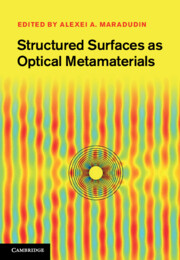Book contents
- Frontmatter
- Contents
- List of contributors
- Preface
- 1 Physics of extraordinary transmission through subwavelength hole arrays
- 2 Resonant optical properties of nanoporous metal surfaces
- 3 Optical wave interaction with two-dimensional arrays of plasmonic nanoparticles
- 4 Chirality and anisotropy of planar metamaterials
- 5 Novel optical devices using negative refraction of light by periodically corrugated surfaces
- 6 Transformation of optical fields by structured surfaces
- 7 Surface electromagnetic waves on structured perfectly conducting surfaces
- 8 Negative refraction using plasmonic structures that are atomically flat
- 9 Anomalous transmission in waveguides with correlated disorder in surface profiles
- 10 Cloaking
- 11 Linear and nonlinear phenomena with resonating surface polariton waves and their applications
- Index
- Plate section
- References
5 - Novel optical devices using negative refraction of light by periodically corrugated surfaces
Published online by Cambridge University Press: 01 June 2011
- Frontmatter
- Contents
- List of contributors
- Preface
- 1 Physics of extraordinary transmission through subwavelength hole arrays
- 2 Resonant optical properties of nanoporous metal surfaces
- 3 Optical wave interaction with two-dimensional arrays of plasmonic nanoparticles
- 4 Chirality and anisotropy of planar metamaterials
- 5 Novel optical devices using negative refraction of light by periodically corrugated surfaces
- 6 Transformation of optical fields by structured surfaces
- 7 Surface electromagnetic waves on structured perfectly conducting surfaces
- 8 Negative refraction using plasmonic structures that are atomically flat
- 9 Anomalous transmission in waveguides with correlated disorder in surface profiles
- 10 Cloaking
- 11 Linear and nonlinear phenomena with resonating surface polariton waves and their applications
- Index
- Plate section
- References
Summary
Introduction
Negative refraction (NR) has been theoretically predicted [1, 2] and experimentally realized [3–7] in three types of materials. One is a material with a simultaneously negative permittivity and permeability [8–12], leading to a negative refractive index for the medium. The second consists of a photonic crystal (PhC) [13–21], which is a periodic arrangement of scatterers in which the group and phase velocities can be in different directions leading to NR. The third is the indefinite medium [22–28], whose permittivity and/or permeability tensor is an indefinite matrix. In all cases, the bulk properties of the medium, which is inherently inhomogeneous at a subwavelength scale, can be described as having an effective negative refractive index. The active research in these artificial materials has opened doors to a plethora of unusual electromagnetic properties and new applications such as a perfect lens [29], subwavelength imaging [30], cloaking [31], slow light, and optical data storage [32, 33], that cannot be obtained with naturally occurring materials. The holy grail of manufacturing these artificial photonic metamaterial structures is to manipulate light at the nanoscale level for optical information processing and high-resolution imaging.
In order to achieve NR, engineering the bulk electromagnetic properties is normally needed such that the group velocity and phase velocity be at an obtuse angle or even anti-parallel to each other. However, refraction is a surface phenomenon. A bulk-engineered material will have certain inherent surface properties. Negative refraction can be realized in positive index materials by special orientation or by engineering the interface properties.
- Type
- Chapter
- Information
- Structured Surfaces as Optical Metamaterials , pp. 158 - 184Publisher: Cambridge University PressPrint publication year: 2011



